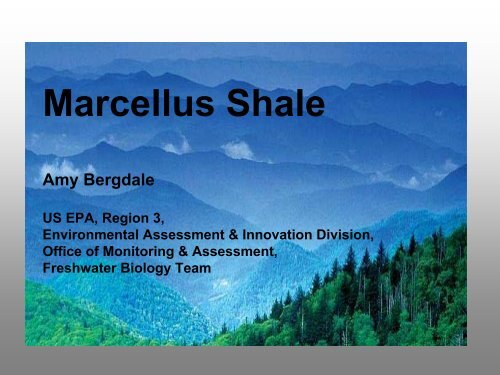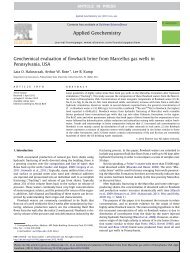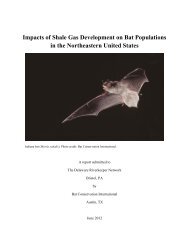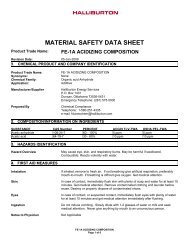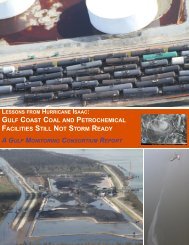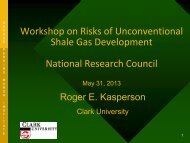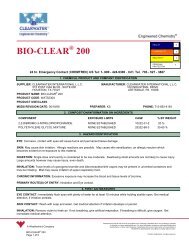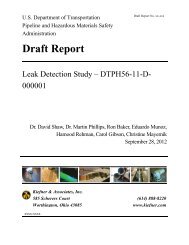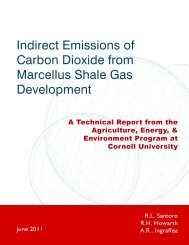EPA Powerpoint Presentation on Marcellus Shale Wastewater
EPA Powerpoint Presentation on Marcellus Shale Wastewater
EPA Powerpoint Presentation on Marcellus Shale Wastewater
Create successful ePaper yourself
Turn your PDF publications into a flip-book with our unique Google optimized e-Paper software.
<strong>Marcellus</strong> <strong>Shale</strong>Amy BergdaleUS <str<strong>on</strong>g>EPA</str<strong>on</strong>g>, Regi<strong>on</strong> 3,Envir<strong>on</strong>mental Assessment & Innovati<strong>on</strong> Divisi<strong>on</strong>,Office of M<strong>on</strong>itoring & Assessment,Freshwater Biology Team
Who is <strong>Marcellus</strong>??•Brief History of Natural Gas•Sources of Natural Gas•Exploring the <strong>Marcellus</strong> <strong>Shale</strong>•Waste Characteristics of the <strong>Marcellus</strong><strong>Shale</strong>, including TENORM•Reas<strong>on</strong>able Potential of thepollutants of c<strong>on</strong>cern: bothaquatic and human health•Reality of the Issue
Discovery of Natural Gas1815 – Charlest<strong>on</strong>, WVThe first Natural Gaswell discovered byaccident
Discovered in Appalachia•World’s 1 st commercial oil well in 1859,Titusville, PA.•Natural gas was an accidental andunderestimated by-product of the oil rush of1850s.•Large scale practice of natural gas wasintroduced in late 1800s by Joseph Pews andGeorge Westinghouse for steel and glassindustries in Pittsburgh.•Local gas companies evolved from individualwells to an interstate supply acquired byRockefeller’s Standard Oil.•1950s shifted supply from Appalachia to newdiscoveries of natural gas in Southwest andGulf of Mexico.
Energy C<strong>on</strong>sumpti<strong>on</strong> in theUNITED STATES, 2007
Energy C<strong>on</strong>sumpti<strong>on</strong>World Coal C<strong>on</strong>sumpti<strong>on</strong>2,000.0OIL://www.eia.doe.gov/basics/naturalgas_basics.htmMilli<strong>on</strong> Short T<strong>on</strong>s1,500.01,000.0500.00.019801982198419861988199019921994Source: EnergyInformati<strong>on</strong> Administrati<strong>on</strong>19961998200020022004P20 062008: 23.2 TCFUnitedStatesAll ofEuropeEuras iaChinaIndia
United States Gas Fields
SOURCES of GASSourceTCFAsalouyeh,South ParsGas Field-Iran 500Urengoygas field-Russia 385Iolotan gasfield -Turkmenistan 264Barnett<strong>Shale</strong> - TX 2.1 - 30AnadarkoBasin – TXto KS 100Haynesville<strong>Shale</strong> – GulfCoast 250PrudhoeBay – NorthAK 28<strong>Marcellus</strong> 168 - 516http://s.wsj.net/public/resources/images/P1-AP715A_NATGA_NS_20090429185625.gif
<strong>Marcellus</strong> <strong>Shale</strong>
What is involved w/ <strong>Marcellus</strong>drilling?VERTICAL VS HORIZONTALwww.geoexpro.com
<strong>Marcellus</strong> FracturingWater-GroundwaterMunicipalSurfaceProppant – 30% ofWater volumehttp://geology.com/articles/marcellus-shale.shtml<strong>Shale</strong> &OverburdenAdditives
Additives•Over 300 proprietary additives, including surfactants,biocides, wetting agents, scale inhibitors, organiccompounds (benzene, toluene) etcFracwater ChemistryWetting agent n<strong>on</strong>i<strong>on</strong>ic surfactants 5-9 lbs/ 1000 galFricti<strong>on</strong> reducer ani<strong>on</strong>ic polyacrylamide polymer 3-5 lbs / 1000 galBiocidesdibromo nitrilopropi<strong>on</strong>amide,glutaraldehyde, or n,ndibromosulfamate1-5 lbs / 1000 gal5lb/1000gal5,000,000gal25000 lbsScale inhibitorsEither a Polyacrylate or aPhosph<strong>on</strong>ate, such as aminotrimethylenephosph<strong>on</strong>ate orphosph<strong>on</strong>obutane tricarboxylate1-2 lbs / 1000 gal
What is involved w/ <strong>Marcellus</strong>drilling?LANDUSE ALTERATION &INFRASTRUCTURE•5,000,000 gal•3000 gal/truck•1667 trucks forwater•1.5 milli<strong>on</strong> lbs ofproppant•2000 lbs/truck•750 trucks forproppant•AccessRoads•Well pads•Transportvehicles•Compressi<strong>on</strong>stati<strong>on</strong>s•Cleaningstati<strong>on</strong>s•Pipelines(Nati<strong>on</strong>al Park Service, December 2008)
What is involved w/ <strong>Marcellus</strong>www.geoexpro.comdrilling?••••••VerticalvsHoriz<strong>on</strong>talInfrastructureLandUseAlterati<strong>on</strong>Processwaterproppantsadditivesshale&overburdencompositi<strong>on</strong>SupportingInfrastructureTreatment
TDS - 70,334mg/LCI - 37,460mg/LTDS – N/ACI – 30,000 mg/LTDS – 211,000 mg/LCI – 102,000 mg/LGross alpha – 960 pCi/LTDS – 217,000 mg/LCI – 107,000 mg/LGross alpha – 3420 pCi/LTDS – 132,000 mg/LCI – 121,000 mg/LGross alpha – 3330 pCi/L
Characterizing the WasteStaged Flowback of <strong>Marcellus</strong> Well - WVmg/L140,000120,000100,00080,00060,00040,00020,000700,000600,000500,000400,000300,000200,000100,000mg/L0Day 1 Day 5 Day 10 Day 20 Day 300Chloride Total Dissolved Solids Specific C<strong>on</strong>ductivity
What is in the Waste? fracwater producedwater cuttingssurfactantsorganics TDSmetalsTENORM othertoxicsubstancesCl SO 42Na + K + otheri<strong>on</strong>srad<strong>on</strong> U otherradi<strong>on</strong>uclidesRa 228Ra 226wastetreatment&disposalmethodwastestoragemethod
What is involved w/ <strong>Marcellus</strong>drilling?Treatment of WasteUndergroundInjecti<strong>on</strong>ThermalEvaporati<strong>on</strong>BrineTreatmentDiluti<strong>on</strong>
What is involved w/ <strong>Marcellus</strong>drilling?How much waste?Average Horiz<strong>on</strong>tal Well –•5,000,000 gal H2O (not c<strong>on</strong>sideringproppant and/or additive volume)•Flowback ~60% injectedvolume•1,500,000 gal of waste•Need 500+ trucks to transport
Underground Injecti<strong>on</strong> - PACountyBeaverInjecti<strong>on</strong> Formati<strong>on</strong>Injecti<strong>on</strong>PressureInjecti<strong>on</strong> Volume(Bbls/M<strong>on</strong>th)Huntersville/Oriskany 1300 21,000Clearfield Oriskany 3240 4260Greene Mine Void 0 150,000Erie Gatesburg 1570 45,000Indiana Balltown 1930 3600Somerset Oriskany 3250 27,000Clearfield Oriskany 1450 4200SomersetHuntersville/Oriskany 3218 30,000TOTAL 285,060API37-017-2002737-033-0005337-049-2438837-063-2024637-111-2005937-033-2205937-111-20006
Brine Treatment•VOCs – blown off•Oil & Grease,removed•Metals, removed•Does NOT treatTDS•TDS in = TDS out
Thermal Evaporati<strong>on</strong>•VOCs – blown off•Oil & Grease, removed•Metals, removed•TDS, removed•By-productsSaltWater
Diluti<strong>on</strong>Is Diluti<strong>on</strong>theSoluti<strong>on</strong>?
Is there Reas<strong>on</strong>able Potential tocause harm?Comp<strong>on</strong>ents of Water QualityStandard: <strong>Marcellus</strong> gas drilling•Designated Uses•Water Quality Criteria•Antidegradati<strong>on</strong> policy•General PoliciesWater Quality Criteria:Pollutants = i.e., Metals, TDS, etc.Numeric criteriaChemicalAquatic lifeHuman healthOthers (e.g., wildlife,sediment)Reas<strong>on</strong>able Whole Effluent Potential ToxicityBiologicalNarrative CriteriaReas<strong>on</strong>able Potential -Limitati<strong>on</strong>s must beestablished in permits toc<strong>on</strong>trol all pollutants orpollutant parameters that areor may be discharged at alevel that will cause, , havethe reas<strong>on</strong>able potential tocause, or c<strong>on</strong>tribute to anexcursi<strong>on</strong> above any statewater quality standard [40CFR 122.44(d)(1)(i)].
Calculating Receiving WaterC<strong>on</strong>centrati<strong>on</strong>s Under CriticalC<strong>on</strong>diti<strong>on</strong>s for <strong>Marcellus</strong> Waste• Criteri<strong>on</strong> for protecti<strong>on</strong> of aquatic life fromchr<strong>on</strong>ic effects from Pollutant X (in our case weare using Chloride as our pollutant of c<strong>on</strong>cern)Upstream(Qs, Cs)Downstream(Qr, Cr)Discharge (Qd, Cd)
Current IssueWater leak from Washingt<strong>on</strong> County gaswell kills fishThursday, June 04, 2009By D<strong>on</strong> Hopey, Pittsburgh Post-GazetteA leaking waste water pipe from a Range Resources <strong>Marcellus</strong> <strong>Shale</strong> gaswell drilled in Washingt<strong>on</strong> County's Cross Creek Park has polluted anunnamed tributary of Cross Creek Lake, killing fish, salamanders,crayfish and aquatic insect life in approximately three-quarters of a mileof the stream.The state Department of Envir<strong>on</strong>mental Protecti<strong>on</strong> said Range Resourcesreported the May 26 waste water discharge from a coupling <strong>on</strong> a 6-inchpipe running from a recently drilled well to a waste water impoundment.The DEP has taken water samples of the stream above and below thepolluti<strong>on</strong> release, said Helen Humphreys, a department spokeswoman,and, after those are evaluated, will determine the appropriateenforcement acti<strong>on</strong>.The Range Resources wastewater pipeline c<strong>on</strong>nects three <strong>Marcellus</strong><strong>Shale</strong> deep gas wells drilled in the 3,000 acre county-owned park.Read more: http://www.post-gazette.com/pg/09155/975107-113.stm#ixzz0HZotpuGY&C"It's a gold rush, really. It's a boom," said Steve Rupert, an executive with Range Resources,which is drilling aggressively in the rolling farmland southwest of Pittsburgh. (Washingt<strong>on</strong> Post Aug. 15, 2008)
Determining a Critical Value (Cr)Upstream(Qs, Cs)Discharge (Qd, Cd)Downstream(Qr, Cr)Cr = QsCs + QdCdQrCriteri<strong>on</strong> for protecti<strong>on</strong> of aquatic life from chr<strong>on</strong>ic effects:Qs = Critical stream flow (7Q10) for chr<strong>on</strong>ic criteri<strong>on</strong>Qd = Critical effluent flow from discharge flow dataQr = Sum of critical stream flow and critical effluent flowCs = Critical upstream pollutant c<strong>on</strong>centrati<strong>on</strong>Cd = Critical effluent pollutant c<strong>on</strong>centrati<strong>on</strong>
Characterizing the Waste in PAChloride Brine Data from Western PA12000010000080000mg/L6000040000200000Avg 65600 mg/L
Determining a Critical Value (Cr)Upstream(Qs, Cs)Downstream(Qr, Cr)Cr = QsCs + QdCdQrDischarge (Qd, Cd)•Ohio River, River Mile 40, U.S. Chester, WV•Background chloride 100mg/L•Large 100mgd (155cfs) Treatment Facility•7Q10: 2,060cfs•Max observed is 109000mg/L of 16 samples•Cd = 109000 * 2.5 = 272,500mg/L (assuming99 th percentile, default CV of 0.6)= 19162 mg/L >230 mg/LC<strong>on</strong>clusi<strong>on</strong>: The dischargewould cause, have thereas<strong>on</strong>able potential tocause, or c<strong>on</strong>tribute to anexcursi<strong>on</strong> of the Chr<strong>on</strong>icNati<strong>on</strong>al Aquatic Life Criteriafor Chloride
Determining a Critical Value (Cr)Upstream(Qs, Cs)Downstream(Qr, Cr)Cr = QsCs + QdCdQrDischarge (Qd, Cd)•S.F. Tenmile•Background chloride of 28.5mg/L•Large 0.8mgd (1.23cfs) Treatment Facility•7Q10: 3.75cfs•Max observed is 109000mg/L of 16 samples•Cd = 109000 * 2.5 = 272,500mg/L (assuming99th percentile, default CV of 0.6)= 67,326 mg/L >230 mg/LC<strong>on</strong>clusi<strong>on</strong>: The dischargewould cause, have thereas<strong>on</strong>able potential to cause,or c<strong>on</strong>tribute to an excursi<strong>on</strong>of the Chr<strong>on</strong>ic Nati<strong>on</strong>alAquatic Life Criteria forChloride
What if diluted?VS.Ohio River ReceivingCr = 19162 mg/L > 230 mg/LChr<strong>on</strong>ic Chloride Nati<strong>on</strong>al Aquatic Life Criteria10% = 1916 mg/L5% = 958 mg/L1% = 192 mg/L0.5% = 96 mg/L< 230 mg/LS. F. Tenmile ReceivingCr = 67,326 mg/L > 230 mg/LChr<strong>on</strong>ic Chloride Nati<strong>on</strong>al Aquatic Life Criteria10% = 6733 mg/L5% = 3366 mg/L1% = 673 mg/L0.5% = 337 mg/L
Waste Disposal Methodswastetreatment&disposalmethodretenti<strong>on</strong>p<strong>on</strong>dswastestoragemethodstoragetanksundergroundinjecti<strong>on</strong>wastevolumediluti<strong>on</strong>brinetreatmentthermalevaporati<strong>on</strong> oil&greaseexposureleachate&leakage wateravailabilitybrinewasteblownoffVOCsremovedsurfaceoil&greaseremovedmetalssaltcakePMN 2VOCsevaporatedwaterVOCsdisposedashazardouswastedisposedaslandfillwasteotherdisposalmethodsNO xSO xdischargedtoairdistilledreusedischargedtosurfacewater groundwaterc<strong>on</strong>taminati<strong>on</strong> surfacewaterc<strong>on</strong>taminati<strong>on</strong> soilc<strong>on</strong>taminati<strong>on</strong>
DRAFT– DrillingC<strong>on</strong>ceptualModelAmyBergdale 06/2009ForInternalUseOnly,DoNOTsharedrillsiteinfrastructureverticaldrillinglandusealterati<strong>on</strong>horiz<strong>on</strong>taldrillingdrillingprocesssupportinginfrastructureadditive&proppantthermalmanufacturingplantsevaporati<strong>on</strong>plantsbrinetreatmentplantscompressi<strong>on</strong>stati<strong>on</strong>scleaningstati<strong>on</strong>stransportvehicleswellpadsaccessroadspipelines vegetati<strong>on</strong> wateruptake surfacerunoff permeability groundwaterwatermunicipalwatersupplywatersource surfacewaterproppantssilicasandbauxitesurfactantsfricti<strong>on</strong>reducersbiocidesadditivesacidsotheradditivesoxygenstabilizersshale&overburdencompositi<strong>on</strong> weathering&erosi<strong>on</strong>recycledinitialfracwaterwetvs.dryshale energyexpenditure noise VOCs NO x habitatfragmentati<strong>on</strong> sediment flowalterati<strong>on</strong> wateravailability frac water producedwater cuttings particulatematter otherairpollutants surfactants organics TDSmetals TENORM othertoxicsubstances Cl Na + K +rad<strong>on</strong> U Ra 226 SO 42 otheri<strong>on</strong>s otherradi<strong>on</strong>uclidesRa 228LEGENDhumanactivitywastetreatment&disposalmethodwastestoragemethodsourcestressoradditi<strong>on</strong>alstepincausalpathwaymodifyingfactortreatmentmethodendwasteproduct wateravailabilityundergroundinjecti<strong>on</strong>wastevolumediluti<strong>on</strong>brinewasteblownoffVOCs VOCsbrinetreatmentremovedsurfaceoil&greasedisposedashazardouswasteremovedmetalsdisposedaslandfillwastesaltcakeotherdisposalmethodsthermalevaporati<strong>on</strong>N 2 NO x SO xPMVOCsdischargedtoairevaporatedwaterdistilledretenti<strong>on</strong>p<strong>on</strong>ds oil&greaseexposurestoragetanksleachate &leakagereusedischargedtosurfacewater groundwaterc<strong>on</strong>taminati<strong>on</strong> surfacewaterc<strong>on</strong>taminati<strong>on</strong> soilc<strong>on</strong>taminati<strong>on</strong>
sourcec<strong>on</strong>tributing landscapechangec<strong>on</strong>tributing envir<strong>on</strong>mentalc<strong>on</strong>diti<strong>on</strong>additi<strong>on</strong>al step incausal pathwayinteracting stressorproximate stressormode of acti<strong>on</strong>biotic resp<strong>on</strong>seVisualize linkages b/n sources,stressors, and biological effectsDRAFT– DrillingC<strong>on</strong>ceptualModelAmyBergdale 06/2009ForInternalUseOnly,DoNOTsharedrillsiteinfrastructureverticaldrillinglandusealterati<strong>on</strong>horiz<strong>on</strong>taldrillingdrillingprocessSource = <strong>Marcellus</strong> gas drillingadditive&proppantmanufacturingplantssupportinginfrastructurebrinetreatmentplantsthermalevaporati<strong>on</strong>plantscompressi<strong>on</strong>stati<strong>on</strong>scleaningstati<strong>on</strong>stransportvehicleswellpadsaccessroadspipelines vegetati<strong>on</strong> wateruptake weathering&erosi<strong>on</strong> surfacerunoff permeability groundwaterwatermunicipalwatersupply surfacewaterwatersourcerecycledinitialfracwaterproppantssilicasandbauxiteadditivesshale&overburdencompositi<strong>on</strong>surfactantsbiocidesacidsoxygenstabilizersfricti<strong>on</strong>otherreducersadditiveswetvs.dryshale energyexpenditure noise VOCs NO x habitatfragmentati<strong>on</strong> sediment flowalterati<strong>on</strong> wateravailability frac water producedwater cuttings particulatematter otherairpollutants surfactants organics TDSmetals TENORM othertoxicsubstances Cl Na+ K+rad<strong>on</strong> U Ra 226 SO 42 otheri<strong>on</strong>s otherradi<strong>on</strong>uclidesRa 228LEGENDhumanactivitywastetreatment&disposalmethodwastestoragemethodsourcestressoradditi<strong>on</strong>alstepincausalpathwaymodifyingfactortreatmentmethodendwasteproduct wateravailabilityundergroundinjecti<strong>on</strong>wastevolumediluti<strong>on</strong>brinewastebrinetreatmentblownoffremovedremovedVOCssurfaceoil&metalsgrease VOCsdisposedasdisposedashazardouswastelandfillwastesaltcakeotherdisposalmethodsthermalevaporati<strong>on</strong> PM N 2 VOCs NO x SO xdischargedtoairevaporatedwaterdistilledretenti<strong>on</strong>p<strong>on</strong>ds oil&greaseexposurestoragetanksleachate &leakagereusedischargedtosurfacewaterStressor(s) = i.e., Metals, TDS, etc. groundwaterc<strong>on</strong>taminati<strong>on</strong> surfacewaterc<strong>on</strong>taminati<strong>on</strong> soilc<strong>on</strong>taminati<strong>on</strong>geology & othernatural sourcesagriculturalpracticesfossil fuel extracti<strong>on</strong> &refinement practicesother miningpracticesresidential &commercial practicesindustrialpracticeshistoricalsourcesfire ash &smokeminingwastessepticsystemspower plantreleasesheatingemissi<strong>on</strong>sindustrialemissi<strong>on</strong>sother n<strong>on</strong>-pointsourcesmetallicagrochemicalslandfillsother combusti<strong>on</strong>by-productsvehicleemissi<strong>on</strong>sstormwaterindustrialdrainageeffluentWWTPeffluentother pointsourceswatershed landcover alterati<strong>on</strong>riparian landcover alterati<strong>on</strong> metals in soil metals in wet or drydepositi<strong>on</strong> permeability vegetati<strong>on</strong>acid-forming soils metals insubsurface waters metals insurface runoffacid precipitati<strong>on</strong> metals in dischargedwaters surface runoff delivery of metals to streamchannelalterati<strong>on</strong> channelincisi<strong>on</strong> erosi<strong>on</strong> exposure of metalenrichedrock & soil membrane permeableorganometallic compounds metals sorbed to particles &bound to abiotic ligandspH, redox potential, abiotic ligandavailability, & microbialtransformati<strong>on</strong> free metal i<strong>on</strong>s flocculate binding & uptake atgill epithelium passive diffusi<strong>on</strong>through gill epithelium metal ingesti<strong>on</strong> &adsorpti<strong>on</strong> in gut smothering uptake of nutrients impairment of bloodi<strong>on</strong> regulati<strong>on</strong> tissue c<strong>on</strong>centrati<strong>on</strong> of metals bioaccumulati<strong>on</strong> membrane destabilizati<strong>on</strong> protein damageBiological Effect(s)LEGEND mortality c<strong>on</strong>diti<strong>on</strong> behavior reproductive susceptibility tosuccessother stressors mucous secreti<strong>on</strong>in fish deformitiesother stressors metal-sensitive metal-sensitive lifetaxastages metal-tolerant taxa metal-tolerant life parasitism &stagesdiseasebiologically impaired invertebrate assemblagesDetailed c<strong>on</strong>ceptual model diagram for METALSDeveloped 7/ 2007 by Kate Schofield & Pat Shaw-Allenbiologically impaired fish assemblagesother biological impairments
Waste Disposal Methodswastetreatment&disposalmethodretenti<strong>on</strong>p<strong>on</strong>dswastestoragemethodstoragetanksundergroundinjecti<strong>on</strong>wastevolumediluti<strong>on</strong>brinetreatmentthermalevaporati<strong>on</strong> oil&greaseexposureleachate&leakage wateravailabilitybrinewasteblownoffVOCsremovedsurfaceoil&greaseremovedmetalssaltcakePMN 2VOCsevaporatedwaterVOCsdisposedashazardouswastedisposedaslandfillwasteotherdisposalmethodsNO xSO xdischargedtoairdistilledreusedischargedtosurfacewater groundwaterc<strong>on</strong>taminati<strong>on</strong> surfacewaterc<strong>on</strong>taminati<strong>on</strong> soilc<strong>on</strong>taminati<strong>on</strong>
What is in the Waste? fracwater producedwater cuttingssurfactantsorganics TDSmetalsTENORM othertoxicsubstancesCl SO 42Na + K + otheri<strong>on</strong>srad<strong>on</strong> U otherradi<strong>on</strong>uclidesRa 228Ra 226wastetreatment&disposalmethodwastestoragemethod
Defining Pollutant• Pollutant – 40 CFR 122.2– Dredged spoil, solid waste, incineratorresidue, filter backwash, sewage, garbage,sewage sludge, muniti<strong>on</strong>s, chemical wastes,biological materials, radioactive materials,heat, wrecked or discarded equipment, rock,sand, cellar dirt, and industrial, municipal, andagricultural waste discharged into water
Radi<strong>on</strong>uclide MCLsC<strong>on</strong>taminant MCL (year promulgated) Source Health EffectCombined radium-226/-228 5 pCi/L (1976)(Adjusted) Gross AlphaBeta Particle and Phot<strong>on</strong>Radioactivity299, 1005, 12.49 pCI/L15 pCi/L (not including rad<strong>on</strong>or uranium) (1976)960, 3420, 12500 pCi/L4 mrem/year (look-up table)(1976)Naturally occurs in somedrinking water sources.Naturally occurs in somedrinking water sources.May occur due toc<strong>on</strong>taminati<strong>on</strong> fromfacilities using orproducing radioactivematerials.Some people who drink waterc<strong>on</strong>taining radium –226or -228 in excess of theMCL over many yearsmay have an increasedrisk of getting cancer.Some people who drink waterc<strong>on</strong>taining alphaemitters in excess of theMCL over many yearsmay have an increasedrisk of getting cancer.Some people who drink waterc<strong>on</strong>taining beta andphot<strong>on</strong> emitters inexcess of the MCL overmany years may have anincreased risk of gettingcancer.Uranium 30 µg/L (2000)Naturally occurs in somedrinking water sources.Exposure to uranium indrinking water mayresult in toxic effects tothe kidney. Some peoplewho drink waterc<strong>on</strong>taining alphaemitters in excess of the
•Reas<strong>on</strong>able Potential forRadium 226+228Ohio River, 2060cfs• Max observed, 1005pCi/L * 5.6 = 5628 pCi/L••= 398 pCi/LGross alphaOhio River, 2060cfs• Max observed, 12500pCi/L * 5.6 = 70000 pCi/L•= 4898 pCi/LRadi<strong>on</strong>uclides??••5 pCi/L••15 pCi/LRadium 226+228S.F. Tenmile, 3.75 cfs= 1390 pCi/LGross alphaS.F. Tenmile, 3.75cfs= 17289 pCi/L
undergroundinjecti<strong>on</strong>Waste Disposal Methodswastetreatment&disposalmethodwastevolumeXdiluti<strong>on</strong>Xbrinetreatmentthermalevaporati<strong>on</strong>retenti<strong>on</strong>p<strong>on</strong>ds oil&greaseexposurewastestoragemethodstoragetanksleachate&leakage wateravailabilitybrinewasteblownoffVOCsremovedsurfaceoil&greaseremovedmetalssaltcakePMN 2VOCsevaporatedwaterVOCsdisposedashazardouswastedisposedaslandfillwasteotherdisposalmethodsNO xSO xdischargedtoairdistilledreusedischargedtosurfacewater groundwaterc<strong>on</strong>taminati<strong>on</strong> surfacewaterc<strong>on</strong>taminati<strong>on</strong> soilc<strong>on</strong>taminati<strong>on</strong>
English: Grade 9Unit 12: Stigma and Discriminati<strong>on</strong> (11 periods)Learning Outcomes: By the end of Unit 12 students will be able to discuss the impact of stigma and discriminati<strong>on</strong>Learning focusGrammar: the+singular adjective, present perfect c<strong>on</strong>tinuous (for/since), passive infinitive, there is/are, enough/tooVocabulary: stigma/discriminati<strong>on</strong>, care/support, negative/positive percepti<strong>on</strong>sSocial expressi<strong>on</strong>s: addressing misc<strong>on</strong>cepti<strong>on</strong>sCompetency C<strong>on</strong>tent/Language Item Learning Activities and ResourcesA. ListeningListening text about an individualwho has g<strong>on</strong>e through a lot of upsand downs and been subjected tostigma/discriminati<strong>on</strong>Students will be able to:• listen to a story and predict thec<strong>on</strong>tent using a variety ofc<strong>on</strong>textual clues• listen to a story and identifyspecific informati<strong>on</strong>Students are given title/situati<strong>on</strong> and predict c<strong>on</strong>tent. Students listen to a text readby the teacher and check predicti<strong>on</strong>s.Students listen again and answer questi<strong>on</strong>sE.g. What caused…?Who is resp<strong>on</strong>sible for…?• listen to an interview and beable to identify gist• listen to a story and relate whatthey have heard to their ownlives• agree, disagree and expresssimple counter argumentsInterview with special needspers<strong>on</strong>Present perfect c<strong>on</strong>tinuous (withfor and since)I’ve been using a hearing aid fortwo yearsB. SpeakingThe + singular adjectiveE.g. the poorStudents listen to the interview and identify who is talking about whatStudents listen again and note down the mains points. In groups they talk abutsituati<strong>on</strong> described and relate to their own experiences.Teacher uses the c<strong>on</strong>text of the listening to introduce the present perfectc<strong>on</strong>tinuous with ‘for’ and ‘since’. Students make sentences about the topic andtheir own lives.Students brainstorm the reas<strong>on</strong>s for discriminati<strong>on</strong> and the kinds of people that arediscriminated againstE.g. the uneducated, the elderly, the mentally ill, beggars, the poorTeacher encourages discussi<strong>on</strong>. Teacher puts suggesti<strong>on</strong>s <strong>on</strong> the board andhighlights use of the+ singular adjective to describe groups of people. Studentscopy examples.Students look at pictures of people with special needs. They discuss what theirneeds are and how we can help them using passive infinitivesDesktop/ Files Grades 9 - 12 September 2008 / English Grade 9 Comp 3 CV2 Page 41
2008 Events that Impacted Pittsburgh DistrictWater Management• Summer/ Fall.Multiple requests forwater withdrawalsfrom CorpsReservoirs• August –December. Lowstream flows.M<strong>on</strong><strong>on</strong>gahela 10%of normal
2008 Events that Impacted Pittsburgh District WaterManagementhttp://farm1.static.flickr.com/1/887081_3bec7df264.jpg?v=0•October 10. Hatfield Power Plant Failedair emissi<strong>on</strong>s requirements, businessesnot meeting state mandated criteria, intakec<strong>on</strong>centrati<strong>on</strong>s higher than criteria, etc•October 22. Start of M<strong>on</strong><strong>on</strong>gahela Riverhigh TDS Event. PA State Total DissolvedSolids (TDS) Drinking Water Criteria of500 mg/l exceeded.•October 22 -27. Special release fromSt<strong>on</strong>ewall and Tygart Reservoirs tomitigate elevated TDS in PA•November 7. W PA Drought WatchDeclarati<strong>on</strong>•December 10. Uni<strong>on</strong> Township issued abottled water advisory, water supply of850,000 affected•December 12. High Runoff, TDS beganto decrease
Drinking water of 800,000+ peopleElizabeth C<strong>on</strong>ductivity '03-'05, '08 & '0914001200200920082005100020042003UHMOS/CM80060040020001-Jul17-Jun3-Jun20-May6-May22-Apr8-Apr25-Mar11-Mar26-Feb12-Feb29-Jan15-Jan1-Jan30-De16-Dec2-Dec18-Nov4-Nov21-Oct7-Oct23-Sep9-Sep26-Aug12-Aug29-Jul15-JulDate/Time
Regi<strong>on</strong> 3 Draft Permit Reviews –To Date••4 Proposed Treatment Facilities inPA– M<strong>on</strong><strong>on</strong>gahela River Watershed(3)• TDS impaired – applying500 mg/l– W Br Susquehanna River (1)• Applying PA TDS Strategy• TDS loads up to 522,245lbs/day (equivalent to 156,548 mg/l)3 Existing POTWs accepting brine– Wilkes-Barre proposed TDSload up to 1,194,399 lbs/day
Biological Assessment of theAllegheny and M<strong>on</strong><strong>on</strong>gahela RiversPADEP and <str<strong>on</strong>g>EPA</str<strong>on</strong>g>, 2 yr grant (’08-’09)•Evaluate c<strong>on</strong>diti<strong>on</strong>s via probabilistic survey.•Fish, fish habitat, macroinvertebrate, mussels,water chemistry, plankt<strong>on</strong>, and sediment.•Data will assist in risk assessment frompotential stressors.•Aid in analyzing the potential seas<strong>on</strong>al andyearly variability.•PADEP can develop, implement, and testbioassessment methods to produce anunbiased estimate of the current ecologicalc<strong>on</strong>diti<strong>on</strong>.•PADEP can estimate or develop biologicalcriteria, reference c<strong>on</strong>diti<strong>on</strong>s, and water qualityc<strong>on</strong>diti<strong>on</strong>s in support of the CWA.
RIVER ALERT INFORMATION NETWORK(RAIN)•Protecti<strong>on</strong>measures form thefirst barrier to amultiple-barrierapproach to drinkingwater protecti<strong>on</strong>Source WaterProtecti<strong>on</strong>WaterTreatmentDistributi<strong>on</strong>SystemMaintenanceMultipleBarrierApproachM<strong>on</strong>itoring
RAIN Goals• Provide informati<strong>on</strong> and tools to aid watersuppliers in making decisi<strong>on</strong>s• Improve communicati<strong>on</strong> between watersuppliers about water quality events• Install m<strong>on</strong>itoring equipment at appropriatelocati<strong>on</strong>s and provide operati<strong>on</strong>al training• Develop a secure website to shareinformati<strong>on</strong> about water quality• Improve communicati<strong>on</strong> between watersuppliers, USACE and emergency resp<strong>on</strong>ders
C<strong>on</strong>cept For RAIN• Coverage: Allegheny, M<strong>on</strong><strong>on</strong>gahela,Youghiogheny, and headwatersof Ohio Rivers• Communicati<strong>on</strong> System– Spill Alert/Alarm notificati<strong>on</strong>s– Water supplier Roundtables• M<strong>on</strong>itoring System– On-line, c<strong>on</strong>tinuous m<strong>on</strong>itoring equipment– Operator training• Website Development– Water quality data – historical/current– Links (USGS, NOAA, NWS, USACE)
RAIN’s M<strong>on</strong><strong>on</strong>gahela TDSProject Site Selecti<strong>on</strong> Rati<strong>on</strong>aleEast Dunkard - M<strong>on</strong> intake below Cheat RiverDunkard Valley - M<strong>on</strong> intake below DunkardCreekCarmichael - M<strong>on</strong> intake below WhiteleyCreekBrownsville - M<strong>on</strong> intake below TenmileCreekWashingt<strong>on</strong> Twp - M<strong>on</strong> intake belowRedst<strong>on</strong>e CreekPAWC (A) - M<strong>on</strong> intake in USACE Dam 3PAWC (B) - M<strong>on</strong> intake in USACE EmsworthPoolMcKeesport - Youghiogheny intake 1 milefrom M<strong>on</strong>Pittsburgh - Furthest downstream intake <strong>on</strong>AlleghenyWest View - First intake <strong>on</strong> Ohio River
RAIN’s M<strong>on</strong><strong>on</strong>gahela TDSTen RAIN FacilitiesHACHSC1000•C<strong>on</strong>ductivity•pH•TemperatureProject M<strong>on</strong>itoring EffortFour Remote Tributary SitesHydrolab MS5S<strong>on</strong>de•C<strong>on</strong>ductivity•pH•Temperature
RAIN’s Proposed M<strong>on</strong>itoringEffort11-15 RAIN Member Facilities:HACH Source Water PanelNitrateAmm<strong>on</strong>iaDissolved OxygenUV OrganicsSuspended Solids-TurbidityORP
Waste Characterizati<strong>on</strong> Study•TDS•Metals•Organics•TENORMPhase ISite specific, acrossRegi<strong>on</strong>Phase IITreatment of Waste,‘cradle to grave’
<strong>Marcellus</strong>•Brief History of Natural Gas•Sources of Natural Gas•Exploring the <strong>Marcellus</strong> <strong>Shale</strong>•Waste Characteristics of the <strong>Marcellus</strong><strong>Shale</strong>, including TENORMReas<strong>on</strong>able Potential of thepollutants of c<strong>on</strong>cern: bothaquatic and human health•Reality of the Issue
Questi<strong>on</strong>s to ASKWhat are the characteristics of theWASTE?How is the WASTEbeing treated?What are the characteristicsof the EFFLUENT?What are the characteristics of yourRECEIVING water?Are we PROTECTING theAQUATIC LIFE USE?Are we PROTECTINGHUMAN HEALTH?
<strong>Marcellus</strong> <strong>Shale</strong>


